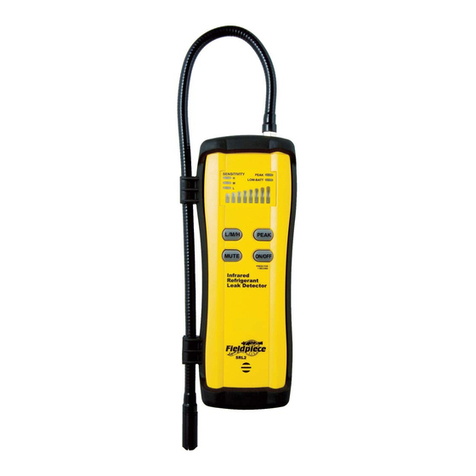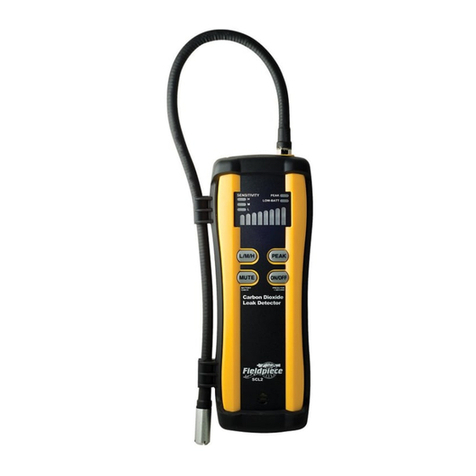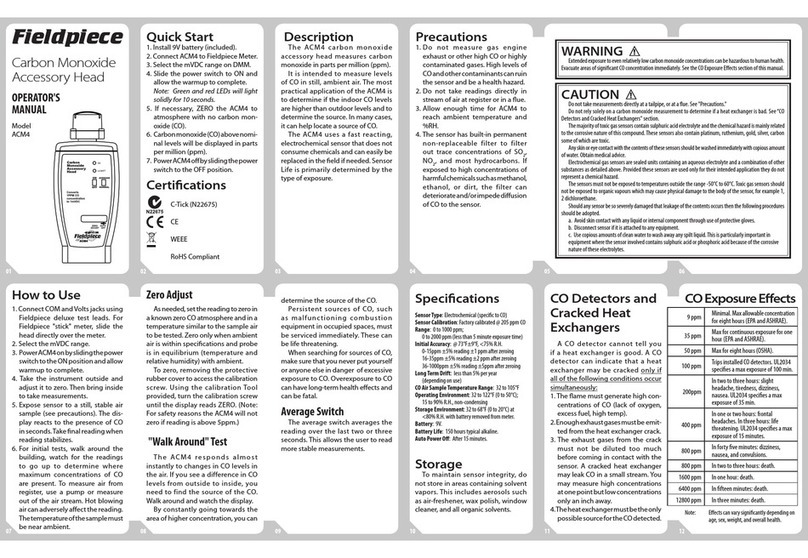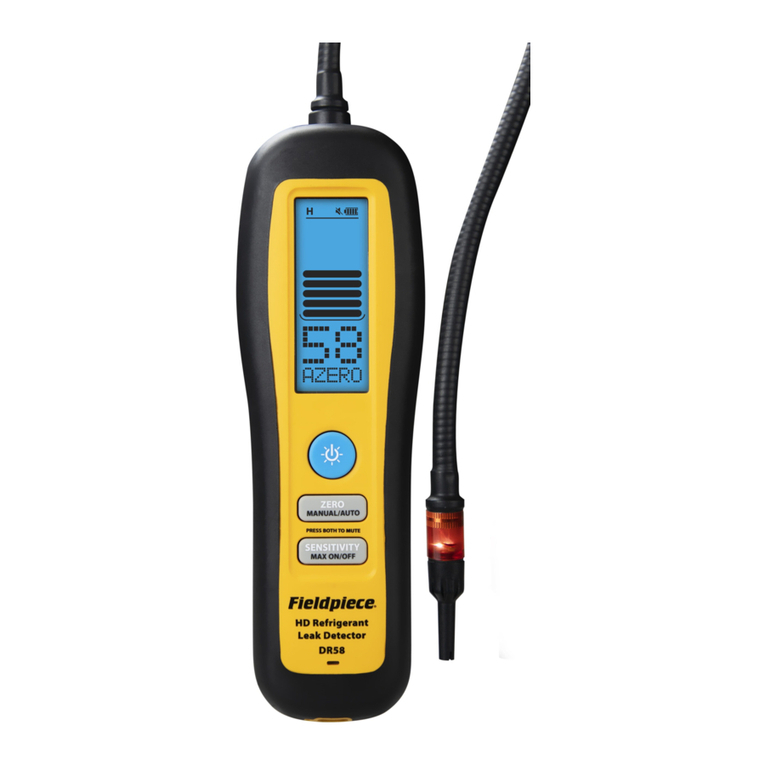13 15 1814 1716
19 21 2420 2322
CO Detectors
& Cracked Heat
Exchangers
A CO detector can't tell you if a heat
exchanger is good. A CO detector can
indicate that a heat exchanger may
be cracked only if all of the following
conditions occur simultaneously:
1. The flame must generate high
concentrations of CO (lack of oxygen,
excess fuel, high temp).
2. Enough exhaust gases must be
emitted from the heat exchanger
crack.
3. The exhaust gases from the crack
must not be diluted too much before
coming in contact with the sensor. A
cracked heat exchanger may leak CO
in a small stream. You may measure
high concentrations at one point
but low concentrations only an inch
away.
4. The heat exchanger must be
the only possible source for the CO
detected.
Maintenance
Clean the exterior with a dry cloth.
Do not use liquid.
Battery Replacement
When the meter displays the
battery should be replaced. Turn your
SCM4 off and replace the 9V battery.
Check Your Sensor:
Coffee Cup CO Test
To demonstrate that your CO
sensor works, turn a ceramic coffee
cup upside down and slide it over
the edge of a counter (or desk) to
expose about a third of the mouth
of the cup. Burn a cigarette lighter
inside the exposed mouth of the cup.
Don't burn the counter. When the
flame starts to flicker, you've burned
up most of the oxygen in the cup cre-
ating carbon dioxide and now you're
starting to produce carbon monox-
ide. Bring the flame in and out of the
mouth of the coffee cup to just keep
the flame alive. The longer you keep
the flame flickering, the more CO you
produce. After 10 seconds of flicker-
ing, extinguish the flame and put the
CO head in the mouth of the cup.You
should see readings in the 100s. Take
it out if it approaches 1000PPM.
CO Sensor Replacement
The SCM4 uses a carbon monox-
ide smart sensor. If you are seeing
erratic CO readings or no readings in
a known CO environment, you likely
need to replace the sensor.
1. Obtain replacement sensor model
RCM4 from your local distributor.
2. Removesensorcap by removingthe
4 screws.
3. Directly pull out old sensor.
4. Hold the new sensor by the sides.
While holding the sensor on the
sides;pressdowntosecurethe new
sensor. Donotpressthenewsensor
from the top.
5. If the sensor is incorrectly installed,
"CO Err" will be displayed and the
meter will automatically shut down
after 5 seconds.
Sensor Disposal
The RCM4 replacement carbon
monoxide smart sensor contains
sulfuric as well as precious metals.
The sensor should be recycled prop-
erly through a local electronic waste
center.
Limited Warranty
This meter is warranted against
defects in material or workmanship
for one year from date of purchase.
Fieldpiece will replace or repair the
defective unit, at its option, subject
to verification of the defect.
This warranty does not apply to
defects resulting from abuse, neglect,
accident, unauthorized repair, altera-
tion, or unreasonable use of the
instrument.
Any implied warranties arising
from the sale of a Fieldpiece product,
including but not limited to implied
warranties of merchantability and
fitness for a particular purpose, are
limited to the above. Fieldpiece shall
not be liable for loss of use of the
instrument or other incidental or
consequential damages, expenses,
or economic loss, or for any claim of
such damage, expenses, or economic
loss.
State laws vary. The above limita-
tions or exclusions may not apply to
you.
For Service
In the USA, call Fieldpiece Instru-
ments for one-price-fix-all out of
warranty service pricing. Send check
or money order for the amount
quoted. Send the meter freight pre-
paid to Fieldpiece Instruments. Send
proof of date and location of purchase
for in-warranty service. The meter will
be repaired or replaced, at the option
of Fieldpiece, and returned via least
cost transportation. Outside of the
USA, please visit www.fieldpiece.com
for service contact information.
www.fieldpiece.com
©Fieldpiece Instruments, Inc 2018; v10
More from
Fieldpiece
CO Exposure Effects
Note: Effects can vary significantly depending on
age, sex, weight, and overall health.
9 ppm Minimal.Maxallowableconcentration
for eight hours (EPA and ASHRAE).
35 ppm Max for continuous exposure for one
hour (EPA and ASHRAE).
50 ppm Max for eight hours (OSHA).
100 ppm Trips installed CO detectors. UL2034
specifies a max exposure of 100 min.
200ppm
In two to three hours: slight
headache, tiredness, dizziness,
nausea. UL2034 specifies a max
exposure of 35 min.
400 ppm
In one or two hours: frontal
headaches. In three hours: life
threatening. UL2034 specifies a max
exposure of 15 minutes.
800 ppm In forty five minutes: dizziness,
nausea, and convulsions.
800 ppm In two to three hours: death.
1600 ppm In one hour: death.
6400 ppm In fifteen minutes: death.
12800 ppm In three minutes: death.
APO MAXMIN HOLD SET
CO2
EA
MAX
°F %
%
°C
ENTER
AUTO-OFF
°F
°C
TEMPCAL
PRESSFOR
1SECOND
SOX3
Combustion
Check
Excess Air,
%CO
2
and %O
2
Natural
Gas
Oil
#2
PropaneCustom
EXHAUST
CLEAR
SETCUSTOM
ON/OFF
FUEL
MAX/MIN
MEASURE/HOLD
ADMN2
Dual-Port
Manometer
Accessory
Head
P1
P2
P1-P2
ON
0.1 ENGLISH
METRIC
0.01
(LCD/10)
Lo Batt
Resolution
ZERO AUTO
OFF
P1 P2
80
AAT3
In-Duct
Psychrometer
& Air Velocity
Head
ON
LO BATTAVG
ENGLISH
ENGLISH METRIC
RH%
Ft/min
°F
RH%
M/s
°C
METRIC
DRY BULB
WET BULB
DEW POINT
AVG
NORMAL
AUTO OFF
SVG3
Fieldpiece
VACUUM
GAUGE
MIN
ALARM
ENTER
UNITS
Digital Refrigerant Manifolds
Accessory Heads
CombustionCheck withAutoPump Vacuum Gauge
Incorrect

























